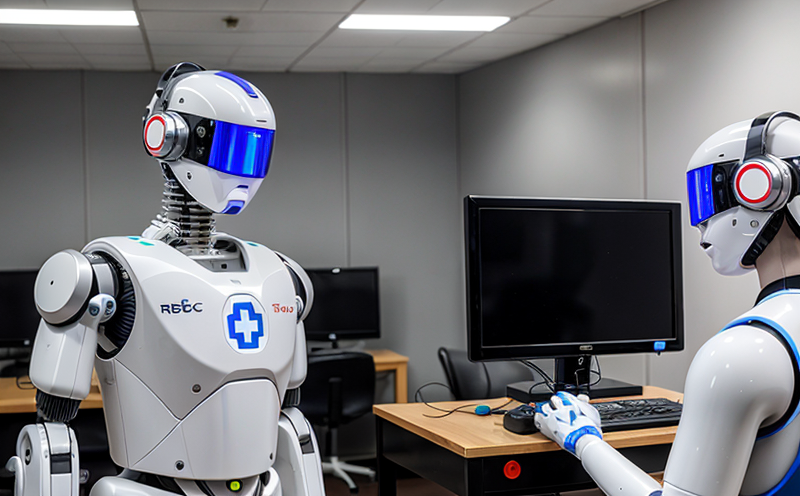IEC 61010-1 Laboratory Service Robot Safety Testing
The International Electrotechnical Commission (IEC) Standard 61010-1: 2018 is widely recognized as the international consensus for safety testing of electrical equipment, including service robots. This standard ensures that devices are designed and manufactured to meet stringent safety requirements, thereby protecting users from potential hazards such as electric shock, fire, or mechanical injury.
In the context of service robotics, these safety measures are particularly critical due to the close interaction between robots and human environments in various sectors, including healthcare, logistics, and domestic settings. Compliance with IEC 61010-1 is essential for manufacturers aiming to penetrate international markets that demand stringent regulatory compliance.
This service involves a comprehensive evaluation of safety-related characteristics such as electrical insulation integrity, protection against electric shock, and the robustness of mechanical components. The testing process ensures that robots meet the necessary criteria set forth in this standard before they are deployed in real-world applications.
The service is particularly relevant for medical robotics, where patient safety is paramount. Hospitals, research institutions, and medical device manufacturers can leverage this service to ensure their robotic systems comply with global standards, enhancing trust and reliability among healthcare providers.
In summary, the IEC 61010-1 testing ensures that service robots are safe for use in various environments. This service is crucial for maintaining high safety standards and regulatory compliance across different sectors.
Scope and Methodology
The scope of this IEC 61010-1 Laboratory Service Robot Safety Testing includes a detailed examination of the following parameters:
| Parameter | Description |
|---|---|
| Electrical Insulation Integrity | Evaluation of insulation materials and their resistance to breakdown under specified conditions. |
| Protection Against Electric Shock | Assessment of the effectiveness of protective measures against electric shock hazards. |
| Mechanical Robustness | Detailed inspection of mechanical components for durability and resistance to stress. |
| Cable and Wire Bonding | Verification that all electrical connections are properly bonded according to the standard. |
| Protective Measures Against Overload | Evaluation of mechanisms designed to prevent damage from overloads. |
| User Interface Safety | Assessment of safety features in user interfaces that ensure safe operation by users. |
The testing methodology involves the following steps:
- Initial Inspection: A thorough review of design drawings, documentation, and specifications to identify potential hazards.
- Component Testing: Individual tests on each component to ensure compliance with safety requirements.
- Safety System Verification: Confirmation that all safety systems are functioning as intended under various operational scenarios.
- End-to-End Testing: Comprehensive testing of the entire system, including integration and interaction between different components.
All tests are conducted in a controlled laboratory environment to ensure consistent and repeatable results. The findings are documented comprehensively for future reference and compliance verification.
Quality and Reliability Assurance
The quality and reliability of the service are paramount, as they directly impact the safety and performance of service robots. To ensure high standards of quality:
- State-of-the-Art Facilities: Our laboratory is equipped with the latest testing equipment and infrastructure to meet the strictest international standards.
- Expertise and Experience: Our team comprises highly skilled engineers and technicians who are experts in interpreting IEC 61010-1 requirements.
- Comprehensive Reporting: Detailed reports are provided, highlighting any non-compliance issues along with recommendations for corrective actions.
- Continuous Improvement: We regularly update our testing protocols to align with the latest standards and industry best practices.
The reliability of the service is further enhanced by our commitment to long-term support. Post-testing, we offer guidance on necessary modifications or improvements to ensure continuous compliance with safety regulations.
Environmental and Sustainability Contributions
In addition to ensuring high levels of safety, this testing contributes significantly to environmental sustainability:
- Eco-Friendly Design: By promoting the use of safe and reliable service robots, we contribute to reducing the environmental impact associated with unsafe or malfunctioning equipment.
- Extended Operational Lifespan: Ensuring robust mechanical components through comprehensive testing leads to longer operational lifespans, thereby minimizing waste.
- Reduced Risk of Accidents: Safe robots reduce accidents and injuries, leading to a reduction in the environmental burden associated with medical care and recovery.
The service also aligns with broader sustainability goals by fostering trust in advanced technologies that can be deployed safely across various sectors. This contributes to more responsible technological advancement and deployment.





